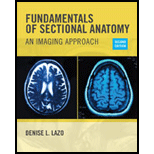
Match each of the following terms with the correct meaning.
________ Ventral
a. Lying on the back, face upwards
b. Farther from the point of attachment
c. The front of the body or body part
d. Toward the tail end of the spine
Introduction:
The directional terms are used in anatomy, which describes the positions of structures relative to other structures or locations in the body.
Explanation of Solution
Justification for correct answer:
Option (c) is given as the front of the body or body part is referred as ventral. In biological anatomy, ventral signifies body part closer to the front side of the body. For example, the eyes are ventral to the brain. Hence, (c) is the correct option.
Justification for incorrect answers:
Option (a) is given as lying on the back, face upward is referred as ventral. Supine position signifies lying on the back with face upward while ventral signifies body part closer to the front side of the body. Hence, (a) is an incorrect option.
Option (b) is given as farther from the point of attachment is referred as ventral. Distal position signifies farther from the point of attachment while ventral signifies body part closer to the front side of the body. Hence, (b) is an incorrect option.
Option (d) is given as toward the tail end of the spine is referred as ventral. Caudal position signifies toward the tail end of the spine while ventral signifies body part closer to the front side of the body. Hence, (d) is an incorrect option.
Want to see more full solutions like this?
Chapter 1 Solutions
Fundamentals of Sectional Anatomy: An Imaging Approach
- What did the Cre-lox system used in the Kikuchi et al. 2010 heart regeneration experiment allow researchers to investigate? What was the purpose of the cmlc2 promoter? What is CreER and why was it used in this experiment? If constitutively active Cre was driven by the cmlc2 promoter, rather than an inducible CreER system, what color would you expect new cardiomyocytes in the regenerated area to be no matter what? Why?arrow_forwardWhat kind of organ size regulation is occurring when you graft multiple organs into a mouse and the graft weight stays the same?arrow_forwardWhat is the concept "calories consumed must equal calories burned" in regrads to nutrition?arrow_forward
- You intend to insert patched dominant negative DNA into the left half of the neural tube of a chick. 1) Which side of the neural tube would you put the positive electrode to ensure that the DNA ends up on the left side? 2) What would be the internal (within the embryo) control for this experiment? 3) How can you be sure that the electroporation method itself is not impacting the embryo? 4) What would you do to ensure that the electroporation is working? How can you tell?arrow_forwardDescribe a method to document the diffusion path and gradient of Sonic Hedgehog through the chicken embryo. If modifying the protein, what is one thing you have to consider in regards to maintaining the protein’s function?arrow_forwardThe following table is from Kumar et. al. Highly Selective Dopamine D3 Receptor (DR) Antagonists and Partial Agonists Based on Eticlopride and the D3R Crystal Structure: New Leads for Opioid Dependence Treatment. J. Med Chem 2016.arrow_forward
- The following figure is from Caterina et al. The capsaicin receptor: a heat activated ion channel in the pain pathway. Nature, 1997. Black boxes indicate capsaicin, white circles indicate resinferatoxin. You are a chef in a fancy new science-themed restaurant. You have a recipe that calls for 1 teaspoon of resinferatoxin, but you feel uncomfortable serving foods with "toxins" in them. How much capsaicin could you substitute instead?arrow_forwardWhat protein is necessary for packaging acetylcholine into synaptic vesicles?arrow_forward1. Match each vocabulary term to its best descriptor A. affinity B. efficacy C. inert D. mimic E. how drugs move through body F. how drugs bind Kd Bmax Agonist Antagonist Pharmacokinetics Pharmacodynamicsarrow_forward
- Basic Clinical Lab Competencies for Respiratory C...NursingISBN:9781285244662Author:WhitePublisher:Cengage
 Medical Terminology for Health Professions, Spira...Health & NutritionISBN:9781305634350Author:Ann Ehrlich, Carol L. Schroeder, Laura Ehrlich, Katrina A. SchroederPublisher:Cengage Learning
Medical Terminology for Health Professions, Spira...Health & NutritionISBN:9781305634350Author:Ann Ehrlich, Carol L. Schroeder, Laura Ehrlich, Katrina A. SchroederPublisher:Cengage Learning - Essentials of Pharmacology for Health ProfessionsNursingISBN:9781305441620Author:WOODROWPublisher:Cengage





